Great Discoveries of the Bible
— A Landmarks of Faith Seminar —
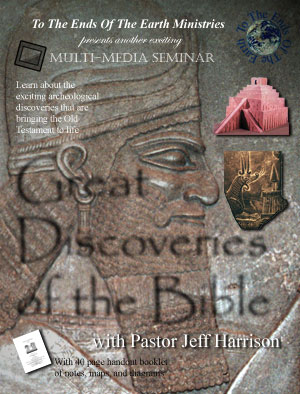
Lecture #4a Audio
 See notes below.
See notes below.Lecture #4a:
Or click here for more listening options at Internet Archive.
__________________________
Lecture #4a Notes
THE BATTLE OVER JOSHUA
1) The Unified Migration View: This is the picture presented by the Bible itself, in which the Israelites came from Egypt all together at one time in a single, massive migration led by Moses.
2) The Multi-Wave Migration View: That different tribes came to Israel at different times, only some of whom came with Moses. Later, they say, the memory of all these different migrations were mixed together as a single event.
3) The Peasant Revolt Theory: Slaves revolted from their masters in the Canaanite city-states and gathered together in the hill country. Here they invented a unifying myth
to give themselves an identity: the myth of the Exodus and Conquest.
The Amarna Letters: Letters from the rulers of Canaan to the pharaohs of Egypt (Amenhotep III and Amenhotep IV). They describe an invasion from the east of a people they call the Habiru (or Apiru). This invasion took place against the same cities and at the same time as Joshua’s invasion of Canaan in the Bible.
EGYPT’S 18TH DYNASTY
(partial)
- Amenhotep II (1450-1425): Exodus (1446). After Amenhotep’s 4th year (the date of the Exodus) Egyptian invasions of Canaan cease (because of the destruction and turmoil of the plagues).
- Thutmose IV (1425-1417): Israelites wander in the desert. Thutmose is not Amenhotep’s eldest (who was killed in the plagues), but a younger son who did not expect to reign. Only one northern campaign. Peace treaty established with Mitanni against the Hittites.
- Amenhotep III (1417-1379): Israelite conquest of Canaan (begins 1400). Amarna Letters start to appear concerning the invading Habiru. No Egyptian military response.
- Amenhotep IV (1379-1362): Israelite conquest continues. More Amarna Letters about the Habiru. Still no military response. Egyptian army called back to Egypt to help with religious reforms that allow worship of only one god (due to a loss of faith in the old gods as a result of the plagues?)
- Tutankhamun (1361-1352): Restores ancient worship. His unrobbed tomb (the tomb of King Tut) was discovered in modern times.
Amenhotep IV (Akhenaten): The “heretic pharaoh” who suppressed the worship of Egypt’s many gods and replaced it with the worship of one god, Aten, the disk of the sun.
Tutankhamun (“King Tut”): The son of Akhenaten. Restored the worship of Egypt’s many gods.
Tell El Amarna: Site of Akhenaten’s new capital where the Amarna Letters were discovered. (Known to the Egyptians as Akhetaten.)
Quotes from the Amarna Letters:
Let the king [pharaoh] my lord protect his land from the hand of the Apiru.
The chief of the Apiru has risen against the lands that the god of the king [pharaoh], my Lord, gave me.
The land of the king [pharaoh] is lost; in its entirety it is taken from me; there is war against me, as far as the lands of Seir [Edom in the south] and as far as Gath-Carmel [Mt. Carmel in the north].
Lost are the lands of the king [pharaoh]! Do you not listen to me? All the governors are lost; the king, my lord, does not have a single governor left! ... The Apiru plunder all the lands of the king!
Habiru (Apiru): Also appear in records from many other parts of the Middle East, which clearly are not referring to Israelites. The name is a general word used for displaced persons and mercenaries, similar to our word refugee. But this name would also apply quite well to the Israelites as they were seen by the Canaanites.
The Kings of Canaan: Were rulers of small city-states, independent cities that were their own countries, like the tiny country of Luxembourg in Europe.
CROSSING THE JORDAN
Jericho: The initial point of Israelite attack across the Jordan River (see event #3 on the map below).
Central Benjamin Plateau (marked “Benjamin” on the map below, west of Jericho): An uplifted area in the center of the hill country of Canaan. This was a strong, defensible position. From here, the Israelites could expand out into other areas.
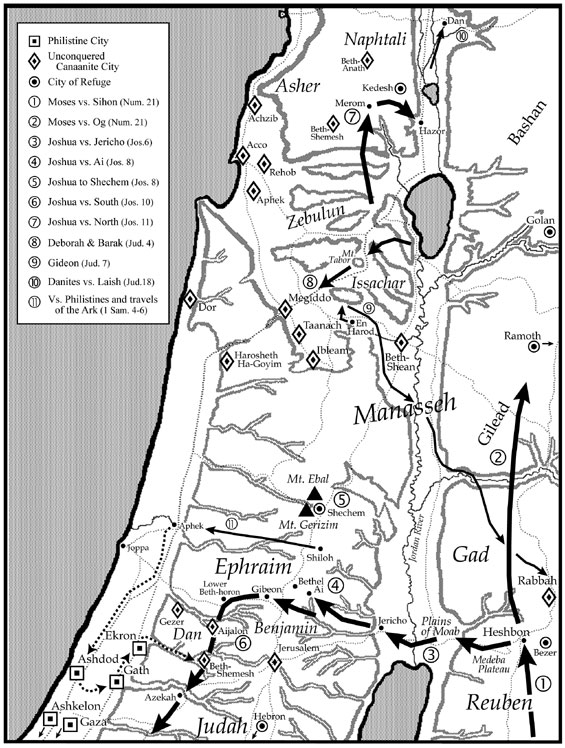
Kherem: Devoted to God, that is, devoted to destruction. A city that was declared kherem belonged wholly to God. Its spoils could not be taken for personal gain.
Gen. 15:16: the iniquity of the Amorite...
Josh. 5:14: And he said,
No, for I have now come, the captain [or commander] of the army of the Lord,
and Joshua fell on his face to the ground...
Josh. 6:2: And the Lord said to Joshua,
See, I have given Jericho into your hand, with its king and the valiant warriors.
Josh. 3:15-16: And when those who carried the ark came into the Jordan, and the feet of the priests carrying the ark were dipped in the edge of the water (for the Jordan overflows all its banks all the days of harvest), that the waters that were flowing down from above stood and rose up in one heap, a great distance away at Adam, the city that is beside Zarethan; and those that were flowing down toward the sea of the Arabah, the Salt Sea [the Dead Sea], were completely cut off. So the people crossed opposite Jericho.
Adam: A city eighteen miles upstream from Jericho, where steep cliffs occasionally erode and fall into the river. If the
mudslide is great enough, it can block the flow of the river for several hours.
JERICHO
Kathleen Kenyon: Controversial excavator of Jericho (in the 1950’s) who declared that no one was living at Jericho in the time of Joshua.
John Garstang: Previous excavator at Jericho (in the 1930’s) who claimed that City IV
had been destroyed in the time of Joshua.
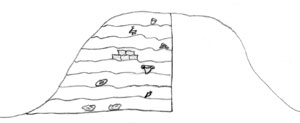
Tell: A hill-shaped ruin heap created by one city being built on the ruins of another over a long period of time.
Bryant Wood: A young archeologist who has challenged the conclusions of Kenyon. He claims that the pottery evidence overwhelmingly supports the conclusions of Garstang.
Glacis: A steep, artificial slope or embankment that is part of the defenses of a fortress or city.
Josh. 2:15: Then she [Rahab] let them down with a rope through the window, for her house was by an [inner] surface of the wall, and she was living within the wall.
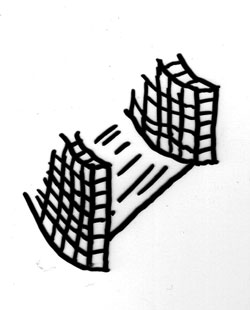
Josh. 6:20: ...the wall fell down flat so that the people went up into the city, every man straight ahead, and they took the city
Jer. 10:10: At his [God’s] wrath, the earth quakes
Josh. 6:24: And they burned the city with fire...
Discovery: City IV was burned after being destroyed by an earthquake. Many containers filled with grain were also discovered.
Josh. 2:6: But she [Rahab] had brought them up to the roof and hidden them in the stalks of flax which she had laid in order on the roof.
THE ALTAR ON MT. EBAL
(Event #5 on the map above)
Deut. 27:12-13: When you cross the Jordan, these will stand on Mount Gerizim to bless the people: Simeon, Levi, Judah, Issachar, Joseph, and Benjamin. And for the curse, these will stand on Mount Ebal: Reuben, Gad, Asher, Zebulun, Dan, and Naphtali.
(This was carried out in Josh. 8:30-34)
Deut. 27:5: You will build there an altar to the Lord your God, an altar of stones; you will not wield an iron tool on them...and you will offer on it burnt offerings to the Lord your God.
Exo. 20:26: You will not go up by steps to my altar, so that your nakedness will not be exposed.
SHECHEM
Lab’ayu: The ruler of Shechem, mentioned in the Amarna Letters: Lab’ayu...gave over the land of Shechem to the Habiru
(Letter of Abdi-Kheba, Canaanite ruler of Jerusalem, to Pharaoh; EA 289).
Gen. 34:10: In this way you will live with us, and the land will be open before you; live and trade in it, and acquire property in it.
(Also Gen. 34:15,24. The covenant between Jacob’s sons and the people of Shechem, though entered into deceitfully, nevertheless resulted in many of the people of Shechem being joined to Israel; Gen. 34:29. This explains why the Shechemites were included in the division of the land in the time of Joshua: ...for the rest of the sons of Manasseh according to their families...and for the sons of Shechem...
; Josh. 17:2.)
Josh. 8:35: ...before all the assembly of Israel with...the strangers that were living among them
Also Josh. 8:33.
Josh. 9:6: And they [the Gibeonites] went to Joshua to the camp at Gilgal, and said to him and to the men of Israel,
We have come from a far country; now therefore, make a covenant with us.
SOUTHERN CAMPAIGN
(Event #6 on the map above: starting at Gibeon)
Josh. 10:3-4: Therefore Adoni-zedek king of Jerusalem sent word to Hoham king of Hebron and to Piram king of Jarmuth and to Japhia king of Lachish and to Debir king of Eglon, saying,
Come up to me and help me, and let us attack Gibeon, for it has made peace with Joshua and with the sons of Israel.
Josh. 10:9: So Joshua came on them suddenly by marching all night from Gilgal.
Josh. 10:11: As they fled from before Israel, while they were at the descent of Beth-horon...the Lord threw large stones from heaven on them as far as Azekah, and they died; there were more who died from the hailstones than those whom the sons of Israel killed with the sword
Megacryometeors: Huge hailstones that fall out of a clear sky.
Rev. 16:21: And a great hailstorm, with hailstones weighing about ninety pounds each, comes down from heaven upon mankind...
Josh. 10:12-13: ...Sun, stand still at Gibeon, and moon in the valley of Aijalon.
So the sun stood still, and the moon stopped, until the nation avenged themselves of their enemies. Is it not written in the book of Jashar? And the sun stopped in the middle of the sky, and did not hasten to go down for about a whole day.
The Day of the Lord: The miraculous future day mentioned by the prophets in which God will destroy his enemies. According to the book of Revelation, it will last a thousand years (Rev. 20:1-7).
NORTHERN CAMPAIGN
(Event #7 on the map above: at Merom. Hazor is just to the east.)
Josh. 11:1 Then it came about, when Jabin king of Hazor heard of it...
Hazor: A massive Canaanite city, the size of cities in Mesopotamia to the north.
Josh. 11:10: ...for Hazor formerly was the ruler of all these kingdoms
Josh. 11:5: So all of these kings having agreed to meet, came and encamped together at the waters of Merom, to fight against Israel
Josh. 11:7: So Joshua and all the people of war with him came on them suddenly by the waters of Merom, and attacked them
Josh. 11:10-11: Then Joshua turned back at that time, and captured Hazor and struck its king with the sword.... And he burned Hazor with fire
Discovery: Recent excavations at Hazor have discovered a palace from the time of Joshua, with signs it was destroyed suddenly by an intense fire. Idols all over the city had their heads and hands cut off.
(The Amarna letters also mention Hazor: The king of Hazor has left his palace and has gone out to join the Habiru. May the king [pharaoh] be apprised concerning this rebellious man, because he has given over the land of the king to the Habiru
; Letter of Abi-milki, the king of Tyre, EA 148.)
ISRAELITE SETTLEMENT
Despite the words of conquest that appear in the book of Joshua, archeology and the Bible itself both make clear that many Canaanites remained in the land for many years.
Evidence of the Israelite settlement: Hundreds of small stone villages appear exactly where the Bible says the Israelites settled, often with houses arranged in a circle.
Judg. 5:24: Most blessed of women is Jael...most blessed is she of women in the tent
Judg. 7:8: Gideon sent all the other men of Israel each to his tent...
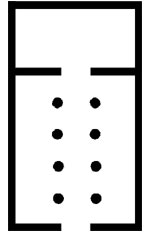
2 Kings 13:5: ...and the sons of Israel lived in their tents as formerly
(See also Psa. 78:55, 1 Chron. 4:41, 5:10; Jer. 30:18, 35:7.)
Broadroom: A rectangular room with the entrance in the middle of one of its long sides.
Four-room Israelite house (or pillared house
): The standard house plan for Israelite homes had a broadroom at the back and three long rooms in front, the center one of which was usually a courtyard open to the sky. The other long rooms on the sides could be used for animals, workshops, or additional housing.
Aliyah: Hebrew for upper room.
The Israelite houses sometimes had a second storey, as in 2 Kings 4:10: Let us make a little walled upper chamber [aliyah].